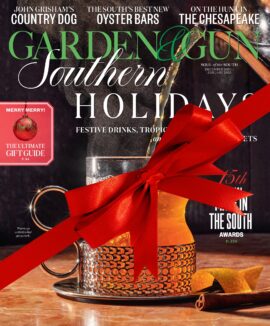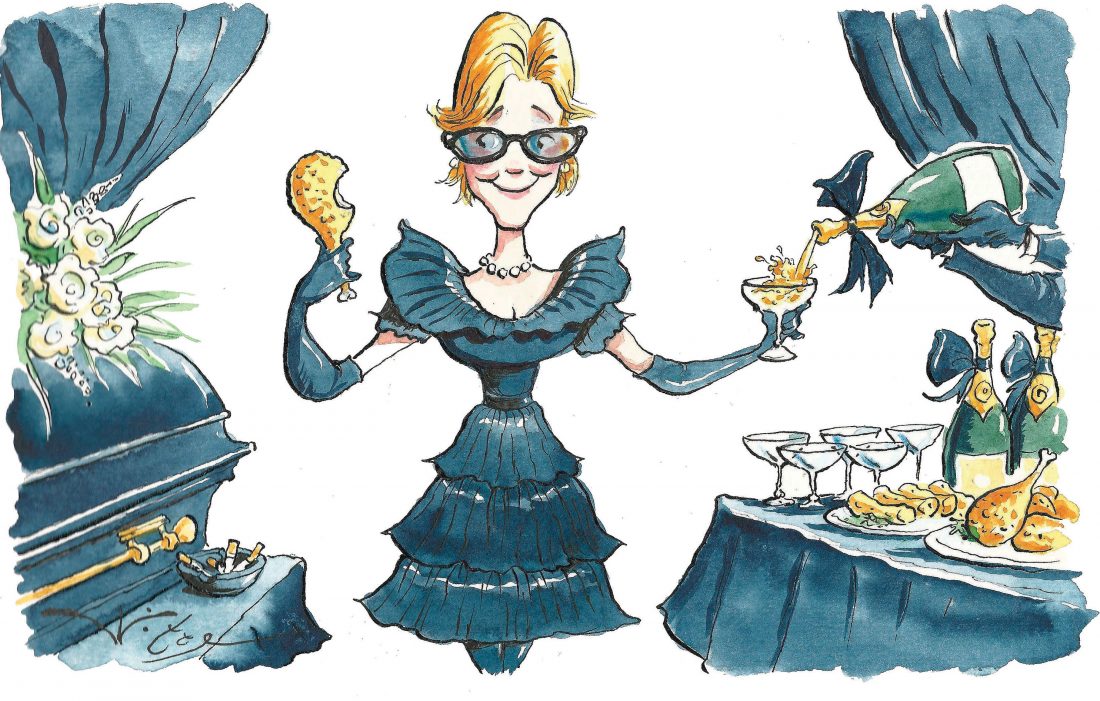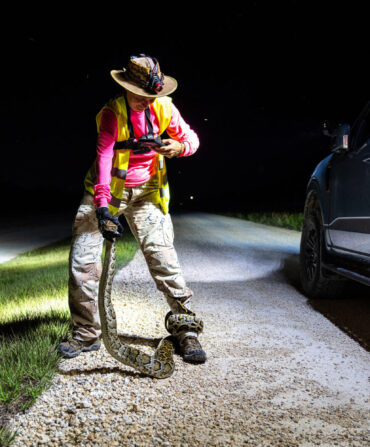This past April in New Orleans, Mickey Easterling, a woman described in various obituaries as a “philanthropist and party giver,” attended her own funeral. I realize it’s true that we all, in one form or another, attend our own funerals, but Easterling was not lying quietly in a coffin or residing in a tasteful urn. She was sitting upright, on a platform erected for the occasion, decked to the nines in a big black hat and a hot-pink feather boa, a cigarette holder in one manicured hand and a Waterford crystal flute of champagne in the other.
The event, held in the grand Italianate lobby of the newly restored Saenger Theatre on Canal Street, was attended by more than a thousand people and made the news as far away as Ottawa and London, where people were riveted by the details, most of which had been carefully planned by the, um, hostess. Among the tidbits reported: the items atop the wrought-iron table next to the garden seat in which she sat (champagne bucket containing an open bottle of Veuve Clicquot, coffeetable book on hats, pack of Natural American Spirit cigarettes); the ferns and pots of white phalaenopsis orchids flanking the “stage” to approximate her own backyard pool patio; the fact that she wore her favorite jeweled brooch (spelling out the word bitch); and her age, eighty-three, which seemed a tad unfair since most of the articles also quoted one of her trademark lines (“Age is a number, and mine’s unlisted”).
There was no program, just a jazz combo on a balcony above and a whole lot of people approaching the “garden area” and raising their glasses (and their camera phones) to the figure before them. “It was a very pleasant effect,” her friend, the Tennessee Williams scholar Kenneth Holditch, told a reporter with the Canadian Broadcasting Corporation. “At first I hesitated to even go look, but when I did…it was not unseemly.” Sammy Steele, who did her makeup, went further: “She looks wonderful. She is a living legend, even in death.”
I will have to take their word for it, though the large color photo on the front page of the New Orleans Advocate, the city’s new daily, was perhaps a tiny bit jarring, if not flat-out grotesque. Still, Easterling was not the first New Orleans “legend” to make a splashy exit. When Ernie K-Doe (the rhythm and blues singer most famous for the 1961 hit “Mother-in-Law”) died, in 2001, his widow, Antoinette, commissioned an effigy, made from a department store mannequin, so that he could remain a presence, seated on a throne in their nightclub, the Mother-in-Law Lounge. Dressed in an ever-changing selection of his former performing outfits, the look-alike K-Doe—in real life he had often referred to himself as the Emperor of the Universe—was also occasionally taken out for public appearances by his wife before she died, in 2009. Then, two years ago, there was Lionel Batiste, the bass drummer of the Treme Brass Band, who attended his wake leaning against a street lamp, wearing a hat and suit and his familiar watch, whistle, and rings. That had been the doing of his son, who had promised his father that he would “send [him] off good” and enlisted the help of the funeral director, Louis Charbonnet. “You have to think outside the box,” Charbonnet told the Times-Picayune. “And so he’s outside the box. We didn’t want him to be confined to his casket.”
Putting aside the fact that this seemingly growing trend of dead people sitting and standing around all over town is getting to be unsettling, I was interested in Easterling’s painstaking orchestration of her own departure. There was, for example, the dress she wore by Leonard, a French fashion house known for its thin silk jersey pieces in splashy prints. A friend of mine who is a frequent international traveler also wears Leonard—the clothes weigh almost nothing and rarely wrinkle—so Easterling’s choice seemed the perfect thing for what is presumably the ultimate trip. Then there was the champagne. Prior to her demise, Easterling drank a lot of it. She even carried around a little case of Waterford flutes because she didn’t like imbibing her favorite Veuve Clicquot from inferior vessels. But it was generous of her to share. Veuve for a thousand is no small investment in something destined to go flat in your glass.
And there was the food: fried eggplant, lump crabmeat in pastry shells, and fried oysters. Now, these happen to be some of the exact things I serve at most of my own parties—and a far cry from the funeral food we are used to in my part of the world (casseroles, weird layered salads, fried chicken, pound cake, tomato aspic). Funeral food is such an exhaustive culinary and cultural subject that Gayden Metcalfe, from my hometown of Greenville, Mississippi, devoted an entire book to the subject, called Being Dead Is No Excuse. In another book by Michael Lee West, called Consuming Passions: A Food-Obsessed Life, the author includes a “Funeral Food” chapter in which she advises against fare like that served at Easterling’s farewell: “I myself have never seen appetizers at a funeral.”
Of course, Easterling’s affair was not the usual post–church service groaning-board, but a cocktail party (or, in the words of her daughter, “a really nice way to say, ‘The party’s over’”). But I started thinking: If we plan everything else about the way we go out (hymns and readers, casket versus cremation), why not plan the menu? Even death-row inmates get to choose their last meal. Since for the rest of us the exact date for that particular repast is a tad harder to predict, we can do the next best thing by arranging for a swell meal for our mourners.
In her book, the skittish West also counsels against bringing desserts with names like Death by Chocolate, but if there’s any occasion that calls for humor on a menu, it is this one. So with that in mind, I’ll be serving the delicious champagne cocktail devised by Ernest Hemingway called Death in the Afternoon (an ounce of Pernod or absinthe at the bottom of a flute, topped with chilled champagne), though a Corpse Reviver No. 2 would not be out of place. There will also be a whole lot of tasty appetizers passed on trays, including my mother’s to-die-for (sorry, couldn’t resist) fried eggplant.
Judy’s Fried Eggplant
Serves 6 as an hors d’oeuvre
Ingredients
1 tbsp. salt
1 large eggplant, peeled and sliced crosswise into quarter-inch slices
1 sleeve Ritz crackers (or more, as needed)
3 large eggs, beaten well
Vegetable oil
Preparation
Fill a large bowl with ice water and add the salt. Stir to blend and add eggplant slices. Soak for about an hour. Meanwhile, crush the Ritz crackers by wrapping the sleeve in a dish towel and beating with a rolling pin. Or pulse a couple of times in a food processor. (You want them to have a bit of texture, like coarse bread crumbs, so do not pulverize them too finely.)
Drain the eggplant and dry carefully. Dip each slice in beaten egg to coat well and dredge in cracker crumbs, pressing to make sure they adhere. Transfer each slice as it is coated onto paper towels. Heat about two inches of oil over medium- high heat until very hot. (It should be around 375 degrees—if you don’t have a ther-mometer, stick the handle of a wooden spoon into the oil. If the oil starts steadily bubbling around the handle, you are ready to go.) Fry the eggplant in batches (do not crowd pan) until golden brown, about a minute or two on each side. Add more oil as needed.
Drain on paper towels and sprinkle with salt.








